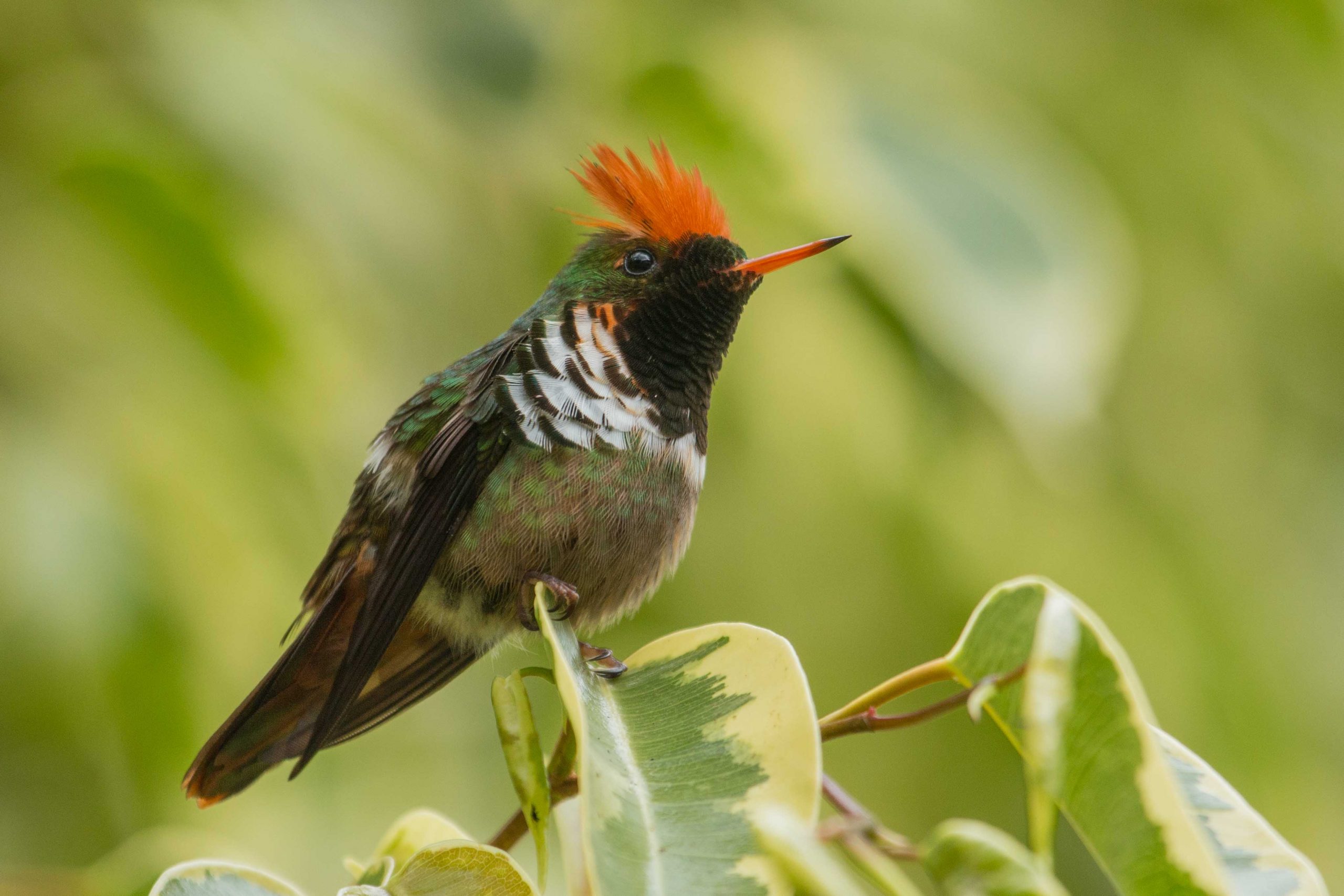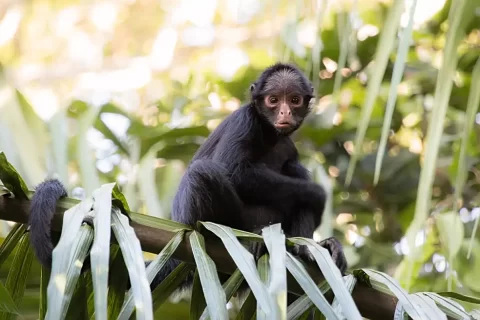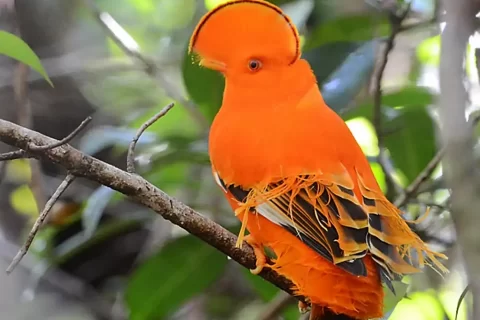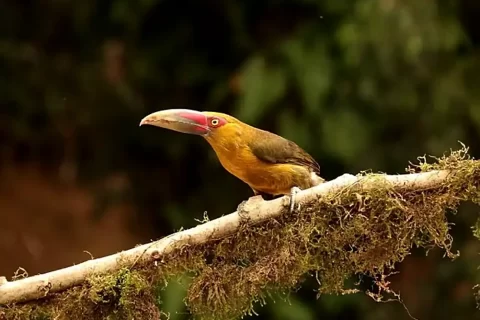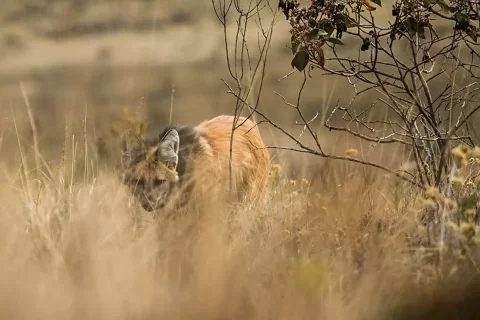Best time of year:
Any time, but best in October & November.
Duration:
8 days
Difficulty:
Moderate. Mostly birding on roads or wide trails, but there are some steep sections at Caetés.
Accommodations:
Comfortable en-suite accommodation throughout the tour. Most hotels have birdy gardens or are located close to the birding sites.
Starts and End in:
Vitória
Tour Overview
The Cherry-throated Tanager (Nemosia rourei), a spectacular endemic of montane Atlantic rainforests in eastern Brazil, is one of the rarest and most endangered birds in the world. There are perhaps fewer than 20 individuals in existence today at just two locations, where they persist on forested hilltops in the heavily fragmented Atlantic forests of south-central Espírito Santo state. However, both known populations are now being monitored, and reserves are being created to protect the birds that remain. Our tour begins with a visit to an important watershed reserve outside the capital city of Vitória where we hope to find rarities such as Buff-throated Purpletuft, Kinglet Manakin and Russet-winged Spadebill. We then head north up the coast to spend three nights in the lowland tabuleiro forests of Linhares, where we search for a host of rare and endangered endemics including such iconic species as the Red-bellied Curassow, Red-browed Amazon, Blue-throated Parakeet and the Atlantic forest race of White-winged Potoo. We stay a night at a lovely little pousada in the hills around the town of Santa Teresa which boasts some of the best hummingbird feeders in eastern Brazil. The remnant forests around the town hold specialties such as Wied’s Tyrant-Manakin and Rufous-brown Solitaire. From Santa Teresa we proceed to the Pedra Azul State Park, visiting a site for the endemic Serra Antwren en route. We save the best for last, with two full days to bird the Caetés forest and neighbouring reserves to look for the Cherry-throated Tanager. Our trip covers the best birding sites in Espírito Santo and it has a bit of everything: wonderful scenery, great food, friendly people, and of course, world-class birding.
Itinerary
Day 1: Arrival.
Arrival in Vitória, the capital of the state of Espírito Santo. Depending on arrival schedules, there may be time to bird mangroves at a local university to try for Mangrove Rail (seasonal), or to visit a nearby site to look for day-roosting Pygmy Nightjars.
Night in Vitória.
Day 2: Duas Bocas Reserve. Drive to Linhares.
In the morning we bird in the Duas Bocas Biological Reserve, a site located about an hour from Vitória. The lowland and lower montane Atlantic rainforest here is home to a number of rarities including Russet-winged Spadebill, Salvadori’s Antwren, Buff-throated Purpletuft, Yellow-eared Woodpecker, Golden-tailed Parrotlet, and Striped Manakin, along with more common Atlantic Forest endemics such as Spot-backed Antshrike, Streak-capped Antwren, Black-capped Foliage-gleaner and Green-headed Tanager. After lunch we head north along the coast to Aracruz, where we stop to visit the Augusti Ruschi Marine Biology Station, where hummingbird feeders attract Minute Hermit and number of other species. From Aracruz we drive another couple of hours to a private reserve administered by the Brazilian mining conglomerate Vale, where we should arrive in the late afternoon.
Night at Vale Linhares Reserve.
Day 3 & 4: Linhares
Together with the neighbouring Sooretama reserve, Linhares comprises part of the largest block of lowland tabuleiro forest in the state of Espírito Santo in addition to being one of the most important forest reserves of the Rio Doce sub-centre of endemism between the south of Bahia and northern Rio de Janeiro. Linhares is chock full of lowland Atlantic Forest endemics, and we’ll have two full days to bird the many sandy tracks looking for the key birds. Foremost amongst these is the endangered Red-billed Curassow, which is nowadays seen only here and at one or two more sites. Driving slowly along the park roads early in the mornings and in late afternoon is the best way to see this species; such drives occasionally turn up other big surprises, such as a Solitary Tinamou, Brazilian Tapir, or even Jaguar! Other key species at Linhares include Red-browed Parrot, White-eared Parakeet, Blue-throated Parakeet, Least Pygmy-Owl, Black-headed Berryeater, Plumbeous Antvireo, Black-cheeked Gnateater, Plumbeous Antvireo, and Band-tailed Antwren. Linhares also holds mega-rarities like Harpy Eagle, the endemic dulcis race of Rufous-vented Ground Cuckoo, and even the previously unknown-in-life Atlantic Forest form of Cryptic Forest-Falcon was seen here in 2012. Night birding could produce Tawny-browed Owl, Black-capped Screech-Owl, Ocellated Poorwill, and with some luck perhaps also the Atlantic form of White-winged Potoo.
Nights at Vale Linhares Reserve.
Day 5: Linhares to Santa Teresa.
We drive from Linhares up into the Espírito Santo uplands to the small town of Santa Teresa. En route we might stop at a scenic park where the endemic Serra Antwren and Velvety Black-Tyrant occur. King Vulture is often seen flying over the cliffs here, and there is even an outside chance for Orange-breasted Falcon. Sites around Santa Teresa hold East Brazilian Chachalaca, Wied’s Tyrant-Manakin and Rufous-brown Solitaire, while the hummingbird feeders at our hotel on the outskirts of town are amongst the best in all of Brazil. The star of the show here is the fabulous Frilled Coquette, while the supporting cast includes Brazilian Ruby, Violet-capped Woodnymph, Amethyst Woodstar, Sapphire-spangled Emerald and Sombre Hummingbird.
Night at Pousada Vita Verde in Santa Teresa.
Day 6: Augusto Ruschi Reserve and travel to Vargem Alta.
The Augusto Ruschi Biological Reserve lies just north-east of the town of Santa Teresa, and it protects ca. 3,500 hectares (8,800 acres) of montane evergreen Atlantic rainforest from 400 to 1000 metres elevation. We bird here along a public road through the reserve, looking for rarities such as Rufous-brown Solitaire, Salvadori’s Antwren, Oustalet’s Tyrannulet, Russet-winged Spadebill, Cinnamon-vented Piha, and Golden-tailed Parrotlet. The supporting cast is excellent, with other species of interest including Atlantic Black-throated Trogon, Spot-billed Toucanet, Crescent-chested Puffbird, Spot-backed Antshrike, Spot-breasted Antvireo, Ochre-breasted and Black-capped Foliage-gleaners, Yellow-green Grosbeak and Blue-naped Chlorophonia. After lunch in Santa Teresa we make a stop outside of town for Serra Antwren, and then we drive for about 3 hours through the mountainous central region of Espirito Santo to our accommodations near the Pedra Azul, an impressive pluton peak in an eponymous state park.
Night at Pousada Aargau near Castelinho.
Day 7 & 8: Mata dos Caetés.
We have two full days to look for the enigmatic and Critically Endangered Cherry-throated Tanager. The tanager hangs on to existence by a thread, with only two known locations for the species and a global population of fewer than 20 individuals. We will visit a recently created reserve administered by the Instituto Marcos Daniel, a local conservation organization. Researchers from the institute monitor the resident population of the tanagers, and we will accompany them in the field to search for the tanagers. In 2020 and 2021, the research team even discovered the first known nests of the species! The montane forests here are rich in endemics and specialties, and our long list of targets in the area include White-necked Hawk, Saffron Toucanet, Spot-billed Toucanet, Tufted Antshrike, Spot-breasted Antvireo, Ochre-rumped Antbird, Ferruginous Antbird, White-bibbed Antbird, Rio de Janeiro Antbird, Variegated Antpitta, Spotted Bamboowren, White-breasted Tapaculo, Such’s Antthrush, Black-billed Scythebill, Pale-browed Treehunter, Hooded Berryeater, Swallow-tailed Cotinga, Cinnamon-vented Piha, Shrike-like Cotinga, Sharpbill, Oustalet’s Tyrannulet, Half-collared Sparrow, Brown Tanager, Brassy-breasted Tanager and Gilt-edged Tanager.
Nights at Pousada Aargau.
Day 9: Return to Vitória.
End of tour.
Possible Combinations and Extensions
Treasures of Minas Gerais
Our Espírito Santo itinerary is a great complement to our Treasures of Minas Gerais tour. Combining the two itineraries one covers the Atlantic Forest and the Cerrado, seeing a terrific range of the specialties of both ecosystems. Please contact us for a customized itinerary.
Rio’s Serra dos Orgãos
A short tour based at either the fabulous REGUA reserve at Guapi-Açu in the lowlands of Rio de Janeiro, or higher up in the mountains near the town of Novo Friburgo. From either of these two bases, we have a mix of on-site birding and day trips to nearby areas to cover a range of elevations and habitats, tracking down rare endemics including Green-crowned Plovercrest, Gray-winged Cotinga, Black-and-gold Cotinga, Three-toed Jacamar and Restinga Antwren. Optional day trip to a lowland reserve for the Endangered endemic Golden Lion Tamarin. Contact us for further details.





